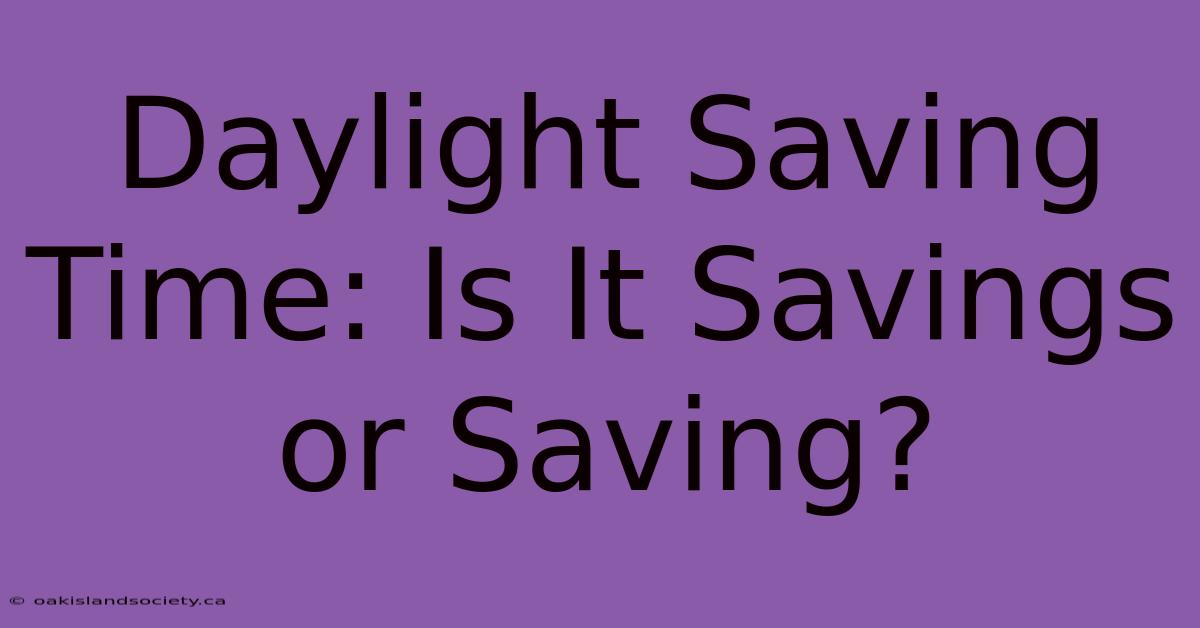Daylight Saving Time: Is It Savings or Saving?
Do we gain an hour of daylight with Daylight Saving Time (DST), or do we simply shift it around? This age-old question sparks debate and confusion every spring and fall. But the answer isn't as straightforward as it seems. Recent studies and legislation are calling the practice into question, raising concerns about its efficacy and even its impact on our health.
Why This Topic Matters:
Daylight Saving Time has been a fixture in many countries for over a century, with the goal of extending daylight hours during the summer months. This practice, often seen as a way to save energy and boost the economy, has become a subject of renewed scrutiny in recent years. This article delves into the history, rationale, and potential downsides of Daylight Saving Time, exploring its complex relationship with our health, energy consumption, and social behavior.
Key Takeaways:
| Key Takeaway | Description |
|---|---|
| DST's Origins and Intent | DST was first implemented during World War I to conserve energy and boost wartime morale. |
| DST's Impact on Energy Consumption | Studies have shown mixed results regarding DST's impact on energy savings, with some research suggesting a slight reduction and others indicating no significant effect. |
| Health Implications of DST | Research points to potential negative health consequences associated with DST, including sleep disturbances, increased risk of heart attacks, and mood disorders. |
| Economic Impact of DST | While DST may have a small positive impact on some sectors, its overall economic benefits are debatable. |
Daylight Saving Time: A Historical Perspective
Daylight Saving Time was first introduced in Germany during World War I to take advantage of longer daylight hours and conserve energy. The United States followed suit in 1918, but the practice was repealed in 1919. It was revived again during World War II and has been in place in the U.S. with some interruptions ever since.
The Debate Over Energy Savings
The primary rationale for DST has been energy savings. The idea is that extending daylight hours in the evening reduces the need for artificial lighting, lowering energy consumption. However, research on this topic has yielded mixed results. While some studies suggest a small reduction in energy use, others show no significant impact.
Health Concerns: Sleep, Heart Health, and Mood
The practice of shifting our clocks forward and backward twice a year can have a significant impact on our circadian rhythm, the body's natural sleep-wake cycle. This disruption can lead to:
Sleep Disturbances: Many individuals struggle to adjust to the time change, experiencing difficulty falling asleep or waking up. This can lead to fatigue, irritability, and decreased productivity.
Increased Risk of Heart Attacks: Research suggests that the disruption to sleep patterns caused by DST may lead to an increased risk of heart attacks and strokes.
Mood Disorders: The shift in our sleep-wake cycle can also exacerbate symptoms of depression and other mood disorders.
Economic Implications: A Mixed Bag
While some sectors, such as retail and tourism, may benefit from the extended daylight hours, the overall economic impact of DST is debatable. Concerns exist about the potential for decreased productivity due to sleep disruption and a possible increase in traffic accidents related to fatigue.
The Future of Daylight Saving Time
The future of DST remains uncertain. Recent legislative efforts in the United States and other countries have called for its elimination or permanent implementation. The debate continues, as proponents and opponents weigh the potential benefits and drawbacks of this longstanding practice.
FAQ:
Q: When was Daylight Saving Time first introduced? A: Daylight Saving Time was first implemented in Germany in 1916.
Q: Is DST mandated by the federal government in the United States? A: No, DST is currently mandated by federal law in the United States, but the specific dates can be adjusted by Congress.
Q: Does DST save energy? A: Research on the energy-saving effects of DST is inconclusive. Some studies suggest a small reduction, while others show no significant impact.
Q: How does DST affect sleep? A: DST can disrupt our circadian rhythm, leading to difficulty falling asleep or waking up.
Q: Is there evidence that DST impacts health? A: Research suggests that DST may contribute to sleep disturbances, an increased risk of heart attacks, and mood disorders.
Q: What are the economic impacts of DST? A: Some sectors benefit from DST, while others may experience negative consequences, making the overall economic impact difficult to assess.
Summary:
Daylight Saving Time is a complex and controversial practice with both potential benefits and drawbacks. While it may offer some economic advantages and a slight reduction in energy consumption, concerns remain about its negative impacts on our sleep, health, and overall well-being. The future of DST is uncertain, but ongoing research and legislative debates will continue to shape its trajectory.
Closing Message:
As we navigate the ongoing discussion about Daylight Saving Time, it's important to be mindful of the potential consequences, both positive and negative, and to prioritize our individual health and well-being. Whether or not DST is ultimately abolished or maintained, the practice serves as a reminder of our ongoing efforts to optimize our relationship with time and its impact on our lives.

